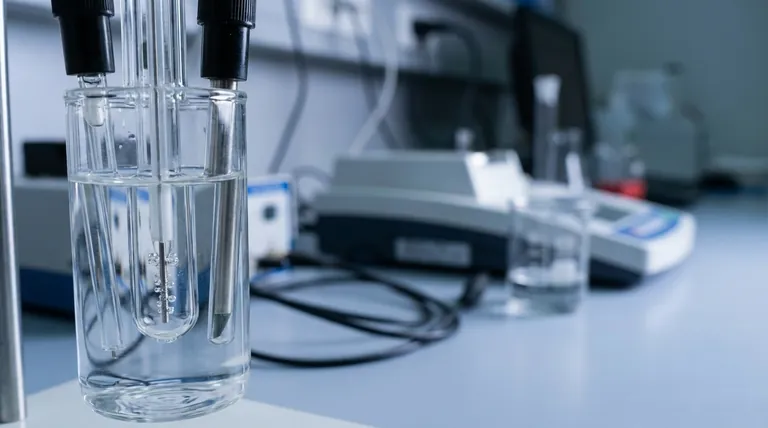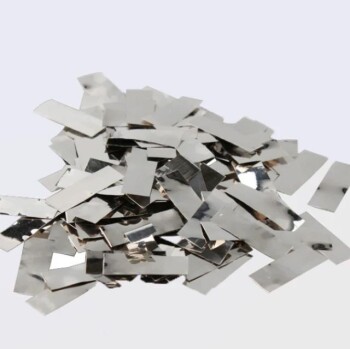In short, platinum wire and rod electrodes are defined by their exceptional chemical stability, high electrical conductivity, and strong catalytic properties. This combination makes them a benchmark standard for electrochemical applications, particularly where data purity and reliability are paramount.
Choosing an electrode is a foundational decision in any electrochemical setup. Platinum wire/rod electrodes are not just a component; they are a guarantee of stability, providing a chemically inert and catalytically active surface that ensures your experimental results are not compromised by the electrode itself.

The Core Performance Pillars of Platinum Electrodes
To understand why platinum is a default choice in many labs, we must look at its key characteristics. These properties work in concert to create a highly reliable and versatile tool.
Unmatched Chemical Inertness
Platinum is a noble metal, meaning it resists chemical reactions, oxidation, and corrosion.
For an electrode, this is its most critical feature. It will not dissolve or react with your electrolyte, even in harsh environments like strong acids (HCl, H₂SO₄, HNO₃) or strong alkalis. This ensures the purity of your experiment and the longevity of the electrode.
High Electrical Conductivity
An electrode's primary function is to transfer charge. Platinum's high conductivity ensures that current can pass through it efficiently with minimal resistive loss.
This means the voltage you apply is delivered effectively to the electrode-electrolyte interface where the reaction occurs, leading to more accurate and controllable experiments.
Superior Catalytic Activity
While chemically inert, platinum is an excellent catalyst for specific, important electrochemical reactions.
It is particularly effective for the hydrogen evolution reaction (HER) and the oxygen reduction reaction (ORR). This catalytic boost lowers the energy required for these reactions to occur, making it an ideal surface for studying them or when they are part of a larger electrochemical system.
Wide Operational Potential Window
An ideal electrode should not undergo its own redox reactions within the voltage range you are studying.
Platinum offers a very wide potential window where it remains stable. This allows you to study a broad range of chemical species without the measurement being obscured by interfering currents from the electrode itself oxidizing or reducing. It's like having a perfectly clear, wide window to observe your reaction.
Form Factor: Why Choose a Wire or Rod?
The shape of an electrode directly impacts its application. Wires and rods offer distinct advantages over other forms like mesh or foils.
Precision and Use in Confined Spaces
The small, defined surface area of a wire or rod is ideal for use as a counter electrode in standard three-electrode cells.
Their slender profile allows them to be easily placed in small-volume cells or complex geometries without physically interfering with the working or reference electrodes.
A Note on Surface Area: Wire vs. Mesh
A platinum wire or rod has a relatively small, well-defined geometric surface area.
In contrast, a platinum mesh electrode is designed to maximize surface area. This makes mesh better for applications requiring high total current, such as bulk electrolysis, while the wire/rod is better suited for analytical techniques where current density is the focus.
Understanding the Trade-offs and Practical Considerations
No material is perfect for every situation. Being aware of platinum's limitations is key to using it effectively.
The High Cost of Platinum
The most significant drawback is cost. As a precious metal, platinum is substantially more expensive than alternatives like glassy carbon or graphite. This makes it less suitable for large-scale or disposable applications.
Sensitivity to Surface Contamination
Platinum's catalytic activity is highly dependent on its surface condition. The surface can be easily "poisoned" or contaminated by impurities in the electrolyte, which can alter experimental results.
For this reason, rigorous cleaning and proper storage are not just recommended; they are essential for obtaining reproducible data. Always inspect the electrode for scratches or stains before use.
Limited Current Capacity
The small surface area of a typical wire or rod electrode means it cannot support very high currents without causing significant changes in the electrolyte (e.g., high local pH shifts). For high-current applications like industrial synthesis, larger sheet or mesh electrodes are necessary.
Making the Right Choice for Your Experiment
Your choice of electrode should always be dictated by your experimental goal.
- If your primary focus is high-precision analytical measurements (e.g., cyclic voltammetry): The stability, wide potential window, and defined surface area of a platinum wire/rod make it an excellent choice for a counter electrode.
- If your primary focus is studying hydrogen evolution or oxygen reduction: Platinum's unparalleled catalytic activity makes it the benchmark material for a working electrode.
- If your primary focus is bulk electrolysis or high-current synthesis: The limited surface area of a wire is a drawback; consider a platinum mesh or sheet electrode instead.
- If your primary focus is cost-sensitive or disposable applications: You may need to explore alternatives like graphite or glassy carbon, while accepting their different performance characteristics.
Ultimately, selecting a platinum wire or rod electrode is a decision for reliability and chemical purity in your electrochemical system.
Summary Table:
| Characteristic | Key Benefit |
|---|---|
| Chemical Inertness | Resists corrosion, ensuring data purity and electrode longevity |
| High Electrical Conductivity | Enables efficient current transfer with minimal resistive loss |
| Catalytic Activity | Boosts key reactions like hydrogen evolution and oxygen reduction |
| Wide Potential Window | Provides a stable, interference-free voltage range for study |
Upgrade your lab's precision with KINTEK's platinum electrodes. Our platinum wire and rod electrodes deliver the chemical stability, conductivity, and catalytic performance you need for reliable electrochemical experiments. Whether you're conducting high-precision analysis or studying specific reactions, KINTEK provides the quality and support to ensure your success. Contact our experts today to find the perfect electrode solution for your laboratory needs.
Visual Guide

Related Products
- Platinum Sheet Electrode for Battery Lab Applications
- Rotating Platinum Disk Electrode for Electrochemical Applications
- Platinum Sheet Electrode for Laboratory and Industrial Applications
- Platinum Auxiliary Electrode for Laboratory Use
- Gold Disc Electrode
People Also Ask
- What is a common use for a platinum sheet electrode? As a Reliable Counter Electrode in Electrochemical Cells
- How can a worn or scratched platinum disk electrode surface be restored? Achieve a Mirror Finish for Reliable Data
- What are the available specifications for platinum sheet electrodes? Find the Perfect Fit for Your Electrochemical Needs
- What is the most critical guideline for immersing a platinum sheet electrode in an electrolyte? Ensure Accurate Electrochemical Measurements
- What are the standard specifications for platinum wire and rod electrodes? Select the Right Form Factor for Your Experiment



















